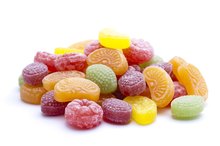The Side Effects of Artificial Food Coloring
Artificial food coloring makes your foods more appealing and desirable. While the safety of these dyes has been called into question, the U.S. Food and Drug Administration maintains that the artificial food coloring currently permitted for use meet strict safety requirements. Consumer advocacy groups and recent scientific research, however, have linked these food dyes to a number of potential health problems, most notably certain types of cancer in animals and attention-deficit disorder and hyperactivity in children.
Safety Restrictions and Rare Allergic Reactions
According to FoodSafety.gov, the FDA uses the best science available to determine whether food additives are safe. When artificial food colors are approved for use, a number of restrictions are specified, including the types of foods they can be used in, the maximum amounts in which they can be used and how the dyes should be identified on food labels. In addition, all approved food colors are subject to ongoing review, as testing methods continue to improve. FoodSafety.gov does note that while it is rare, some individuals can have allergic reactions to particular food colors. As an example, the FDA found that approximately 1 in 10,000 people could experience hives and itching after consuming the artificial food coloring Yellow No. 5 -- a coloring used widely in beverages, desserts, candies and other products.
- According to FoodSafety.gov, the FDA uses the best science available to determine whether food additives are safe.
- FoodSafety.gov does note that while it is rare, some individuals can have allergic reactions to particular food colors.
Links to Cancer
The Effects of Pesticides in Food
Learn More
According to the consumer advocacy group Center for Science in the Public Interest, artificial food coloring and food dyes present many risks to consumers. A report published by the center notes that many commonly used artificial food colors have been found to cause damage to DNA, or genotoxicity, in more studies than they were found to be safe. But the research on artificial food coloring is limited to animal studies, including mice and rats. While bladder tumors and other forms of cancer were linked to certain artificial coloring in these studies, no human trials have found links between cancer and the dyes in humans. The center still contends they are dangerous to consumers and has urged many large manufacturers to discontinue their use.
- According to the consumer advocacy group Center for Science in the Public Interest, artificial food coloring and food dyes present many risks to consumers.
- A report published by the center notes that many commonly used artificial food colors have been found to cause damage to DNA, or genotoxicity, in more studies than they were found to be safe.
The Artificial Food Coloring-ADHD Link
A 2012 paper published in "Neurotherapeutics" examined the controversial topic of artificial food coloring and hyperactivity in children. The article notes a 2011 FDA advisory committee convened for the purpose of evaluating evidence regarding the colors' effects on ADHD in children. The authors note that while artificial food colors are not a major cause of ADHD, they do seem to affect both children with and without ADHD. A 2009 paper published in "Prescrire International" noted that a meta-analysis of 15 double-blind clinical trials found that artificial food coloring increased hyperactive behavior in already hyperactive children. The paper concluded that it is best for children to avoid artificial food colors.
- A 2012 paper published in "Neurotherapeutics" examined the controversial topic of artificial food coloring and hyperactivity in children.
- A 2009 paper published in "Prescrire International" noted that a meta-analysis of 15 double-blind clinical trials found that artificial food coloring increased hyperactive behavior in already hyperactive children.
The FDA Says You're Safe
Saccharin Safety in Toothpaste
Learn More
According to the FDA, the studies showing links between artificial food coloring and ADHD in children have been either inconsistent, inconclusive or hard to evaluate due to poor study design. The FDA also notes that any color additives that have been linked to cancer, in either animals or humans, are banned for use in the United States. Therefore, according to the FDA, all artificial food coloring currently used in the nation have been evaluated for safety using the best scientific research and found not to be cancer-causing in either animals and humans.
Related Articles
References
Writer Bio
Clay McNight is currently a nutrition writer with Demand Media Studios.









